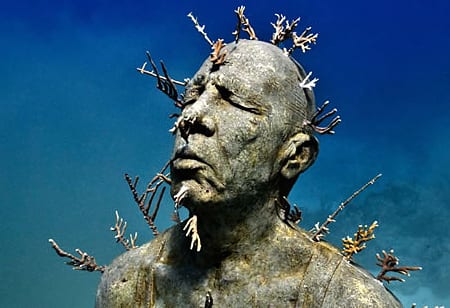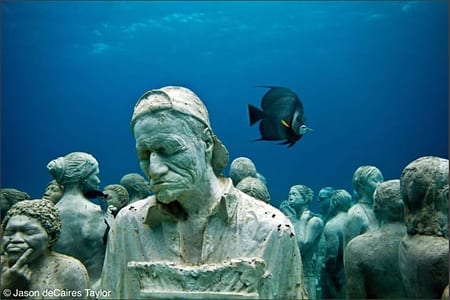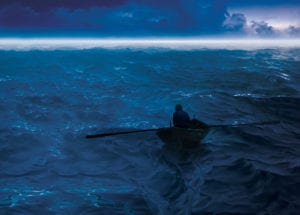By Daniel de la Calle
I was 9 years old in 1981 when a local diver submerged a marble image of the Virgin of Carmen on the beach in front of my house as a sign of gratitude for a personal favor or miracle granted. At the time the event barely made the news, but there it has stayed, on that spot for the past 30 years, many feet underwater, slowly gaining notoriety. It comes up on the first Sunday after each July 16th for devotees, fishermen and scuba divers to worship and then goes back to the sea. I have swam and rowed above the location on several occasions; anyone with the proper equipment or set of lungs can visit it, see her head slightly turned up to the surface, in eerie and perpetual calmness. If I was a religious person I would be overcome with devotion upon this contemplation, for finding traces of people, of human earthly life in that liquid world that is so not our own is always an intense and somehow mystical experience that briefly stops your heart. Whether it is a shipwreck, some archeological remains, a broken fishing net or a simple car tire, it is evident those objects do not belong there, that they represent tragedies, mishaps in various degrees.
My second haunting memory of bodies in the water comes from my early college years; I must have been 19 or 20. On one of those lead-tainted fall days in which water and sky seem one I decided to skip lectures and go to read by the shore. I was aimlessly jumping from rock to rock at the end of a cove when I came upon the drowned body of a young woman, floating very still, head down, as if she was staring at something down, but fully dressed. The water seemed solid, only her loose red hair waved a few millimeters from side to side. It was a horrible mute sight that shaped the way I have felt death ever since, as the representation of an absence. Some time later I learned the tragic story of that poor woman and how currents had dragged her corpse for days from a town west to that lonely spot.
Last Friday I was looking for news about Ocean Acidification to include on this blog when I stumbled upon Jason de Caires Taylor’s work at the National Marine Park in Cancún. A British artist and diver, Jason de Caires Taylor has placed 400 life sized cement “people” off the western coast of Isla Mujeres to serve as an artificial reef for young coral to grow. Hopefully, it will also take part of the stress from the 750,000 annual visitors off the park and into the newly created attraction. The photographs you can see on his website, some of which are displayed below, and the posted videos transmit something hard to put into words. Those hyper-realistic cement women, men and children, have they learned to calmly live underwater, to carry out their daily routines, read, type, stare at each other and hold hands? Are they the ghosts of people on the shore? Fish swim around them, nibble from their cheeks and shoulders, chase each other between the legs. I do not know if they have become accustomed and see those bodies as home, shelter, as a spot in which to find food, or if they feel they have somehow been given the opportunity to go visit us the way divers have been examining them over the past 60 years. The slow, almost invisible transformation of those cement skins into new corals, algae and crustaceans is both disconcerting and quieting; it is like a poetic, metaphorical assurance that, in case we fail as a species, life will eventually take our places, move on. I once read that if we do vanish from Earth and one of those so sought after alien civilizations came to the planet, a few hundred thousand years from now, the only trace they would find of us in geological strata would be a very very thin layer of plastic.
Jason de Caires Taylor also plans to create a series of soluble sculptures to illustrate Ocean Acidification.






